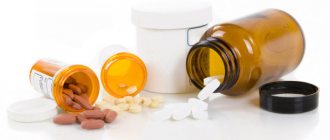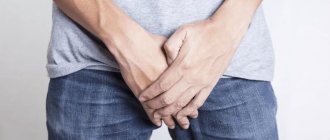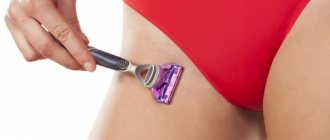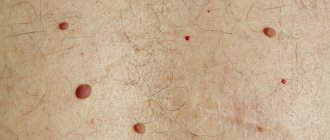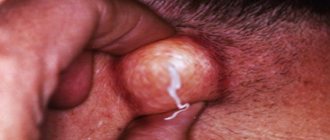Inguinal hernias: causes
Normally, the abdominal wall is capable of supporting all organs located in the abdominal region. But when the framework of the muscles in the lower abdomen loses strength and integrity, the support weakens, and with little effort, the systems and organs fall out or “collapse” into the inguinal canal (the cavity of the groin zone in the male body, where the spermatic cord is located).
What predisposes to the development of the disease? The most common condition for the appearance of a hernia in the groin is considered to be pathology of the inguinal canal. The main reasons are:
- prolonged increase in intra-abdominal pressure (excessive physical activity and work associated with heavy lifting, obesity, overweight);
- condition after surgery on the abdominal and pelvic organs;
- hereditary anatomical inferiority of the walls of the inguinal canal;
- deformations of connective and muscle tissue in old age;
- damage and injury to the tender groin area;
- diseases of the prostate gland and urinary system;
- digestive pathologies;
- bronchopulmonary diseases with a cough component, which puts constant pressure on weakened areas of the abdomen,
- diseases accompanied by chronic constipation, which “undermine” the maintenance of pressure inside the peritoneum;
- low mobility during the day, hypodynamic lifestyle.
A hernial orifice is formed (its internal ring expands in the inguinal canal), and the pelvic organs begin to shift there. They “conquer” a new, abnormal anatomical location – the hernial sac. Thus, under the influence of one or several factors, the formation of a tumor-like hernial protrusion is triggered.
If you notice a bulge in the groin that increases after physical activity and does not bother you at rest, immediately make an appointment with a doctor! You can learn more about the pathology and methods of its treatment at the clinic of Andrei Nikolaevich Begma.
Umbilical Hernia Bulge
Symptoms of inguinal hernia
For men, the main diagnosed sign of the formation of an inguinal hernia is the appearance of a round or oval-shaped swelling. It becomes noticeable visually and when palpated. The appearance of such a dense, protruding formation in the groin area should at least alert you.
At the initial stages, the bulging area can even be straightened out on your own, but at the slightest load it will “return” with a specific rumbling sound. Further, over time, the hernia changes in size: it grows, compresses the groin and anterior-lower areas of the abdomen, causing noticeable pain when moving. The following symptoms are observed:
- Pain in the area of the hernial protrusion of various types (dull, aching, sharp, changing intensity)
- swelling of the soft tissues in the lower abdomen;
- discomfort when walking and physical activity;
- soreness in the lower abdomen, above the pubis;
- burning and tingling in the groin;
- constipation;
- lack of urination or very little urine output;
- when coughing there is a pain sensation in the protruding area.
Patients note an increase in the inguinal hernia and increased symptoms of the inguinal hernia in a state of exertion: when lifting heavy objects, running and/or jumping, vibration, blows to the groin area.
If, after studying this section, you suspect you have an inguinal hernia, you can additionally look at its symptoms in photos and videos on the Internet. It is imperative to consult a surgeon for advice and medical assistance!
Rashes due to allergic reactions and exacerbation of chronic dermatoses
Rashes in the genital area can be a manifestation of allergic reactions - allergic dermatitis, fixed toxicoderma, and also occur during exacerbation of a number of chronic dermatoses - psoriasis and lichen planus. Often, manifestations of vitiligo can be observed in the anogenital area. The types of rash in these cases are extremely variable - spots, papules, blisters and blisters. Rashes with allergic dermatitis are polymorphic. Depending on the duration of the process, red spots, swelling, blisters and microerosions may be observed. As the process subsides, peeling forms. All elements are accompanied by constant itching. Fixed toxicoderma is a variant manifestation of a drug disease with intolerance to certain drugs. Quite large blisters with serous contents are formed, after opening which large erosion occurs. Psoriasis and lichen planus are accompanied by the formation of nodules of various sizes with peeling on the surface. Typically, the appearance of a rash in the anogenital area occurs simultaneously with the appearance of rashes on other areas of the skin. Almost always there is itching of varying degrees of intensity. Vitiligo is a disease associated with the loss of melanin pigment by skin cells, resulting in the formation of whitish spots of various sizes and configurations.
Types of inguinal hernia
Inguinal hernias in men, based on the natural characteristics of the body structure, are divided into acquired and congenital (the nature of the abdominal wall defect is assessed). Also classified into types according to shape:
Get an online consultation
right now.
Get
- Indirect inguinal hernia : The hernial filling is located within the structures and along the inguinal canal. Outwardly, it gravitates towards oblong-elongated shapes. There are three subtypes describing the location: funicular, canal and inguinoscrotal. The hernial sac, accordingly, needs to be looked for at different levels: near the spermatic cord, at the exit from the inguinal canal and down into the scrotum.
- The straight line is characterized by a protrusion outside the spermatic cord, can only be acquired and retains a round (spherical) shape.
- Combined is a formation of greater complexity, which contains at least two hernial sacs and two openings.
If there is excessive overload or pathological weakness of the muscles of the inguinal canal, the patient will experience a phenomenon such as the formation of several simultaneous hernias.
As for the location, the symptoms of an inguinal hernia on the left . The lesions greatly affect the urological system (the prostate gland, bladder, vas deferens). Left-sided hernia is the most serious, sometimes irreversible, threat to men’s health and reproductive ability. “Special” symptoms of this pathology: ejaculation and diarrhea with blood discharge, prolonged constipation, swelling of the testicles and pain when walking.
Symptoms of an inguinal hernia on the right include pain radiating to the lumbar spine, problems with urination, as well as a sharp exacerbation of appendicitis. Bilateral hernias can also form.
What if you don't treat it? Risks and consequences
All types of inguinal hernias (direct, oblique, combined, one- or two-sided) are equally categorically unhealthy for a man’s health and life. You should not start the disease if the first symptoms appear. Among doctors, it is believed that an inguinal hernia is a time bomb. This is true; an advanced disease has dangerous consequences:
- prolapse and dysfunction of internal organs;
- peritonitis and inflammation of tissues inside the abdominal cavity;
- intestinal obstruction and intestinal necrosis;
- destructive changes in the genitourinary system.
If a hernia is not dealt with in the early stages of its manifestation and one continues an unhealthy lifestyle with disproportionate loads, without a diet, and indulging in bad habits, then this is fraught with the above pathologies, an unaesthetic appearance, and unpleasant incidents in the intimate sphere. What the consequences of refusing treatment look like is convincingly shown by photographs of severely ill patients in the late stages of a hernia who are awaiting emergency surgery.
A large percentage of men think that there is nothing terrible about a hernia. However, if left untreated, the risks are very high - unfortunately, there are statistics on cases where a complication (strangulated inguinal hernia) led to death. Even if an indirect hernia found in the groin area does not cause inconvenience and does not manifest itself in disturbing symptoms, surgery to remove it is only a matter of time. And you still have to decide to take this step in order to preserve your health. Timely consultation with a surgeon helps prevent many problems.
Hernia in the groin in men: treatment
There is no option that an inguinal hernia disintegrates or disappears on its own. In the absence of proper treatment, there is a high risk of a chain development of serious complications - necrotic changes in organs and tissues, even death. The only effective method of curing a male inguinal hernia is surgery to remove it in a hospital setting (also called hernioplasty). In modern equipped clinics, an intervention aimed at radically eliminating the problem of hernia filling takes from 30-40 minutes to an hour and a half.
Conservative methods of control are just a list of preventive measures. Folk remedies: compresses, ointments, infusions from plants, as well as special physical exercises will temporarily ease some symptoms, but will not be able to achieve the main thing - to eliminate the reason why inguinal hernias appear and progress: atrophy of the abdominal wall and inguinal canal.
It is better to discuss the use of any non-surgical or alternative therapy with your doctor so as not to cause additional harm to yourself. With a diagnosis such as an inguinal hernia, we do not recommend self-medication - you need qualified help from doctors.
How to treat
Therapy depends on the disease and its causative agents (bacteria, fungi or viruses). If redness is caused by serious illnesses, then treatment should be comprehensive. How to treat redness in the groin in men and the dosage regimen will be chosen by the doctor, based on the general condition of the patient, concomitant diseases and contraindications (if any).
READ ALSO: A pimple on the tongue hurts: what to do, how to treat it and why it happened
Patients are also advised to regularly observe personal hygiene rules, wear underwear made of natural fabrics (cotton or synthetics), and choose hypoallergenic body care products (soaps, shaving creams, shower gels, etc.).
Treatment with medications
In cases where irritation and redness of the groin area was caused by external factors, the use of the following external preparations (ointments, creams, gels) will help.
You can find reviews for each of the products online:
- Bepantol is a cream that helps treat wounds and quickly restore the skin;
- Drapolene is a cream that has an antiseptic effect. Softens and soothes irritated skin, fights itching;
- Pantestin is a gel that prevents the development of infection and relieves inflammation. The gel is a good antiseptic, but it contains alcohol, which causes dry skin;
- Desitin cream is a drug that accelerates the regeneration of skin cells. It prevents sweat and urine from affecting irritated areas by creating a thin film over them. The cream is convenient to use when it is not possible to constantly carry out hygiene procedures;
- Lamisil is a cream that is used for any fungal skin lesions;
- Zinc ointment is an inexpensive drug that successfully combats peeling and irritation of the skin. Relieves redness.
READ ALSO: Otomycosis: when mushrooms grow in the ears
If the redness is caused by internal diseases, the doctor will tell you what ointment or cream is needed. But in addition to local treatment, it is necessary to take medications orally or do intramuscular injections.
Traditional methods
There are different ways to treat redness in the groin using medicinal herbs. You can find information online on how and how to treat redness at home. But before using the prescription, you should consult your doctor.
- For diaper rash, brew a tablespoon of herb with a glass of boiling water. Leave for 20 minutes and strain. Make lotions from the decoction or take a sitz bath (in this case, mix the decoction with boiled water in a 1 to 1 ratio). From medicinal herbs you can choose: chamomile, calendula, sage.
- Oak bark lotions will help with dermatitis. Take 100 grams of powder, add a liter of water and cook for 20 minutes. Apply gauze soaked in the broth to the sore spot.
- If you suffer from erythrasma, then take 100 grams of St. John's wort. Pour a liter of boiling water. After 20 - 30 minutes, take a bath, diluting the broth with the same amount of warm water.
Treatment of inguinal hernia - types of surgery
Doctors operate on hernial protrusions in the groin area using the most modern techniques, choosing the type of intervention that is optimal for the patient. And just two or three decades ago, tension repair was considered the only and main surgical method (the opening of the hernial orifice was “covered” with flaps formed from the tissue of the patient’s abdominal wall). Now they are moving away from this method: it involves a significant number of side effects and cases of recurrent hernias.
Thanks to progress, surgery is shifting towards gentle, innovative operations. The technologies for removing indirect and direct inguinal hernias used in hospitals and clinics are much more effective, less painful, and less long-term in terms of rehabilitation. The use of artificially synthesized materials minimizes rejection reactions. What hernioplastic measures are there to eliminate the pathology quickly and harmlessly:
1. Tension-free method according to Liechtenstein . They use “tension-free” plastic surgery, one in which the material involved – a polymer synthetic mesh – does not require tension and is not rejected by the body. There are already 3D varieties of mesh. Through an incision in the groin, the resulting hernia is reduced or removed, after which an onlay is made instead of the hernia orifice. The surgeon installs a mesh implant in their place with a hole for the spermatic cord and attaches it to the abdominal cavity. The patient can go home a few hours after the operation! Over time, the mesh becomes part of the body. The material under the skin is intertwined with natural tissues and acts as a frame that supports the organs. The downside of the technique is that a small scar remains visible at the incision site.
2. Laparoscopic suturing . They practice the most effective and low-traumatic method of hernia excision - laparoscopic inguinal hernia repair. There is a limitation - it cannot be used in cases where the hernia has become very large.
This operation requires general anesthesia. The technique involves making three neat punctures in the anterior abdominal wall. An instrument is inserted laparoscopically through them and an auxiliary substance, carbon dioxide, begins to be pumped. First, under the influence of gas, the wall of the peritoneum is stretched, and then it is possible to move the hernial sac into the abdominal cavity. Using instruments introduced into the patient’s tissue, the surgeon closes the hernial orifice from the inside with a mesh polymer “patch,” and the excess internal tissue is sutured.
3. Endoscopic surgery . It is recognized in the medical world as the safest and most effective, as it is performed with local anesthesia (rarely with general anesthesia). Tissue damage is minimal, there will be no scar marks on the skin. It can be argued that this is rather a masterly reduction of the protrusion under local anesthesia. Feature - mesh retaining material is implanted between the layers of the abdominal wall. A self-supporting effect is created due to natural pressure in the peritoneum. The progress of the process is monitored by an endoscope, and the surgeon’s actions are broadcast by a video camera on a screen with multiple magnification.
Surgery and rehabilitation for inguinal hernia
Manipulations to eliminate an inguinal hernia in men on the left or right are considered easy for both patients and surgeons - a small surgical field is involved, large incisions are not required. The maximum is done to remove the hernia and prevent its recurrence. As a result of the intervention, doctors surgically remove the protrusion (hernial sac), returning the displaced viscera, vessels and lobes of human tissue to the desired “correct” position. After plastic surgery of the hernial orifice, a polypropylene endoprosthesis-mesh made of synthetic threads serves as support for the inguinal canal and the peritoneum as a whole, and in the future does not interfere with leading a normal, familiar life.
In order to eliminate postoperative complications, it is necessary to remember and carefully follow the doctor’s recommendations:
- take only medications prescribed by the doctor orally and externally;
- bed rest in the first days (up to a week),
- stop smoking and do not drink alcohol;
- adhere to dietary nutrition,
- carefully begin physical activity;
- use the breathing technique “abdominal breathing”;
- keep the incision/puncture site clean and change bandages;
- after removing stitches and bandages, wear and often change underwear made of natural material, ironed with a preheated iron,
- avoid rooms where the temperature, concentration of dust, and humidity are high;
- do not allow any intimate contacts earlier than 14-20 days;
- The first sexual intercourse after surgery should be performed in a gentle manner, without squeezing the hernia area.
The operation in commercial clinics is estimated in the range of 25-90 thousand rubles. The cost consists of the type of manipulation chosen (laparoscopy is the most expensive), medical supplies, anesthesia used (local, epidural or general), the size and location of the hernia, and the qualifications of the operating specialist.
Tablets for itching in the groin area
| Drug name | Characteristic | approximate cost |
| Azithromycin | Prescribed for the treatment of infectious diseases of the skin. It is used in the treatment of erysipelas, and is also effective in the treatment of diseases of a urological and gynecological nature. Refer to broad-spectrum antibacterial agents. | From 50 to 160 rub. |
| Macropen | Antibacterial drug. Used in the treatment of various diseases. | 350 rub. |
| Taquitin | Acts as an additional tool. Has an immunostimulating effect. Helps increase the number of lymphocytes. It is used in the treatment of purulent skin lesions, as well as other viral and infectious diseases. | 900 rub. |
| Arbidol | An antiviral drug that stimulates the production of interferon in the blood. Used as an adjunct to primary therapy. | 500 rub. |
| Crotamiton | It is prescribed for the treatment of scabies, and also helps to cope with the main symptom of the disease - severe itching. | 1400 rub. |
Itching and irritation in the intimate area can occur for various reasons. It is extremely difficult to determine what exactly caused the discomfort. Therefore, you should consult a doctor if you experience discomfort in the intimate area. The doctor will select the necessary treatment and prescribe medications.
Team of Doctors
It is worth noting that the risk of recurrent hernia rarely exceeds 5-10%. Most often, the recurrence of pathology occurs due to ignoring or negligent implementation of medical recommendations. It is extremely rare that it is provoked by technical errors in the operation or untreated chronic diseases of the patient.
Symptoms of recurrent inguinal hernia:
- hematomas that do not resolve;
- suppuration of the suture or wound area;
- recurrence of constipation, diarrhea with blood discharge;
- persistent cough;
- protrusion of the peritoneum and internal organs (looks like a spherical swelling).


